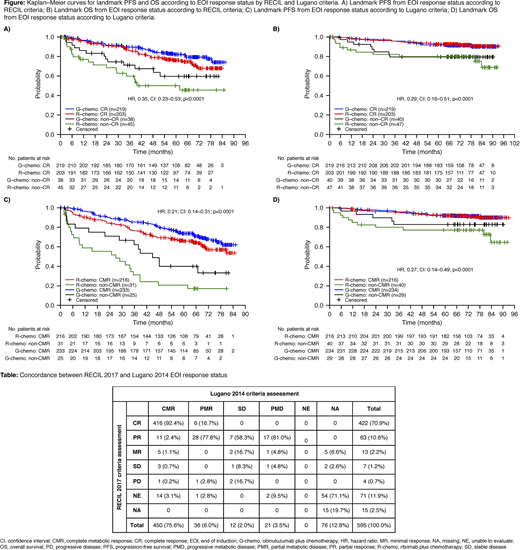Introduction: Lugano 2014 criteria are the current standard for response assessment in lymphoma and incorporate 18F fludeoxyglucose (FDG)-positron emission tomography (PET)-computed tomography (CT) into standard staging of FDG-avid lymphomas (Cheson, et al. J Clin Oncol 2014); bi-dimensional tumor measurements of up to six CT target lesions are used for non-FDG avid lymphomas, and when PET is unavailable. The Response Evaluation Criteria in Lymphoma (RECIL), developed more recently, showed that uni-dimensional measurements of up to three target lesions could provide response assessment at a similar accuracy to the Lugano criteria (Younes, et al. Annals Oncol 2017). In the Phase III GOYA trial (NCT01287741), complete response (CR) status by RECIL criteria showed high concordance with Lugano criteria and was highly prognostic for survival outcome in previously untreated patients (pts) with CD20-positive diffuse large B-cell lymphoma treated with obinutuzumab (G) plus chemotherapy (G-chemo) or rituximab (R)-chemo. Here, we compared the prognostic and predictive performance of the Lugano and RECIL criteria in pts from the Phase III GALLIUM trial (NCT01332968).
Methods: Pts were randomized 1:1 to receive G or R plus CHOP, CVP, or bendamustine (stratification factors: chemotherapy regimen, Follicular Lymphoma International Prognostic Index and geographic region). FDG-PET scans were mandatory in the first 170 pts where a PET scanner was available, and optional thereafter, and were performed at screening and end of induction (EOI). Response was assessed by the investigator (INV) and an independent review committee (IRC) using Cheson 2007 criteria, the IRC also assessed EOI response using Lugano 2014 criteria. Response and progression-free survival (PFS) by RECIL 2017 criteria were retrospectively evaluated via a programming algorithm based on IRC-assessed 5PS scores and the individual lesion measurements from INV assessment. Response categories at EOI by RECIL criteria were cross-tabulated against those by Lugano criteria. Estimates of the treatment effect for PFS were expressed as hazard ratios (HRs) with 95% confidence intervals (CIs) using stratified log-rank tests. Landmark analyses of PFS and overall survival (OS) from EOI, by EOI CR/non-CR status were performed. The impact of covariates on the prognostic value for PFS and OS were analyzed using multivariable Cox models.
Results: In GALLIUM, 1202 pts with follicular lymphoma (FL) were enrolled (601 per treatment arm), of which 595 had PET evaluable data (R-chemo, n=298; G-chemo, n=297). High concordance between Lugano and RECIL criteria for EOI CR was observed regardless of antibody received, with 416 pts classified as CR by RECIL among the 450 pts achieving complete metabolic response (CMR) by Lugano (416/450 [92.4%]; R-chemo, 199/216 [92.1%]; G-chemo, 217/234 [92.7%]) (Table). However, poor concordance was seen for progressive disease (PD), with 18/21 (85.7%) pts with progressive metabolic disease by Lugano classified as partial/minimal responders by RECIL. A strong correlation was observed between Cheson 2007 and RECIL PFS definitions, with a kappa estimate of 0.63 (95% CI: 0.58-0.69). EOI CR status by RECIL showed prognostic value by Cox multivariable regression analysis adjusted for stratification factors for PFS and OS; this prognostic value was similar with Lugano criteria (Figure). PFS rate by treatment arm for pts with a CR/CMR was higher by RECIL versus Lugano for both R-chemo and G-chemo (PFS rate at 3 years from EOI: RECIL: 86.0% and 89.7%; Lugano: 76.4% and 85.0%, respectively); similar results were seen with OS. G-chemo was associated with improved RECIL-PFS (from randomization) compared with R-chemo (HR, 0.72; 95% CI: 0.57-0.91; p=0.0069), similar to the GALLIUM 5-year updated analysis results by Cheson 2007 (HR, 0.76; 95% CI: 0.62-0.92; p=0.0043) (Townsend, et al. ASCO 2020).
Conclusions: RECIL 2017 criteria showed high concordance with Lugano 2014 criteria with EOI CR strongly prognostic for improved outcomes versus non-CR; however, a discordance was observed for PD. A similar treatment difference between arms for PFS was detected with RECIL and Cheson 2007 criteria. RECIL criteria (uni-dimensional assessment of up to three target lesions) may be a suitable alternative to Lugano criteria (bi-dimensional assessment of up to six target lesions) in pts with previously untreated advanced-stage FL.
Kostakoglu:F. Hoffmann-La Roche: Consultancy. Davies:Roche, Celgene, Kite Pharma, Acerta, Karyopharma, Regeneron, Incyte: Consultancy; Roche, Acerta Pharma, AstraZeneca, Celgene, Gilead, ADC Therapeutics, Gilead: Research Funding; Celegene, Roche, Kite Pharma, Celegene: Honoraria; Roche: Other: TRAVEL, ACCOMMODATIONS, EXPENSES. Herold:Helios Klinikum Erfurt: Current Employment; F. Hoffmann-La Roche: Research Funding. Hiddemann:F. Hoffmann-La Roche: Consultancy, Honoraria, Membership on an entity's Board of Directors or advisory committees, Research Funding, Speakers Bureau; Janssen: Consultancy, Honoraria, Membership on an entity's Board of Directors or advisory committees, Research Funding, Speakers Bureau; Gilead: Consultancy, Honoraria, Membership on an entity's Board of Directors or advisory committees, Research Funding, Speakers Bureau. Marcus:Gilead: Consultancy; F. Hoffmann-La Roche: Honoraria; Janssen: Honoraria, Speakers Bureau. Trotman:Celgene: Research Funding; F. Hoffmann-La Roche: Research Funding; BeiGene: Research Funding; Takeda: Research Funding; PCYC: Research Funding. Knapp:F. Hoffmann-La Roche: Current Employment. Mattiello:F. Hoffmann-La Roche: Current Employment. Nielsen:F. Hoffmann-La Roche: Current Employment, Current equity holder in publicly-traded company. Sahin:F. Hoffmann-La Roche: Current Employment, Current equity holder in publicly-traded company. Ward:F. Hoffmann-La Roche: Current Employment, Current equity holder in publicly-traded company. Younes:AstraZeneca: Current Employment; MSKCC: Ended employment in the past 24 months; Janssen, Curis, Merck, Bristol-Myers Squibb, Syndax Pharmaceuticals, F. Hoffmann-La Roche, Curis (Inst), Johnson & Johnson (Inst), Novartis (Inst): Research Funding; Janssen, AbbVie, Merck, Curis, Epizyme, F. Hoffmann-La Roche, Takeda, Bristol-Myers Squibb, Bayer HealthCare Pharmaceuticals, Celgene, Incyte, Janssen Pharmaceuticals, Merck, Sanofi, Seattle Genetics, Takeda Millennium: Honoraria; BioPath, Xynomic, Epizyme, and F. Hoffmann-La Roche: Consultancy.
Author notes
Asterisk with author names denotes non-ASH members.


This feature is available to Subscribers Only
Sign In or Create an Account Close Modal